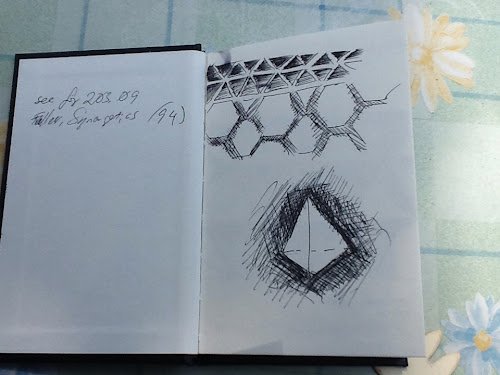I love my sister. That's easy. She's fun, witty, genius smarts, and a heart the size of Dallas, no, Houston, filled with wisdom and compassion. But right now, what I'm appreciating about her is that she gave me an idea, the most precious gift a human being can give another.
She was looking at paintings to put on a wall and she sent me pictures of two of them. Both were the kind corporate-favored abstraction that doesn't threaten perception or inform the viewer. And both were exorbitantly priced. Well, nuts, sez I. I can do better than both those and for loads cheaper (family discounts always apply). But mostly, looking at those pieces reminded me that nothing is abstract.
Principles aren't abstractions, for example. They tend to be deduced from patterns of behavior seen in systems at any scale or in any context where those principles obtain. I think of something Bucky Fuller wrote in part one of his masterpiece "Synergetics": "The physical Universe is a self-regenerative process. It's regenerative interrelationships and intertransformings are generated by a complex code of weightless, generalized principles. The principles are metaphysical." (Synergetics, 220.05)
A lot of what I love to do in art is join the figurative with the abstract (okay, okay...I'll defer to art history here); it could be in the handling of the material that is loose but results in a figurative whole or I've been known to render "realistically" something that doesn't exist or just play with color and line until something strikes my fancy and seems to work.
But I've reached a point in my life where I sense a kind of unifying principle behind all appearances. I realize that we live in an oftentimes binary world of dualities, most of them psychological. They way things appear aren't how things are. Indeed to even speak of things is mistaken. Again, Bucky: "There are no solids or particles -- no- things." (Ibid., 240.08)
So in throwing it out there that I'd be happy to work on a piece for my sister's wall and even sounding like an interior decorator when I asked about the color scheme, I set to work. Thinking. And meditating. Not on any one thing, just being aware and open. But I want to track the development of this piece as an inquiry into the general principle of a how a work, any work, comes to pass.
It's not by accident that I'm referring to Buckminster Fuller. He's been a huge influence on those of us of certain years and backgrounds. He was far ahead of most with his observations and maybe a little off on some, and wonderfully eccentric as an exemplar and a thinker. "Dare to be naive", he wrote. Sorry, not sure the source.
What Fuller opened up to me was grasping at the synergetic operations of the world I encounter. Not in the popular sense that the word is used in corporate boardrooms (my God, business lingo has to turned and twisted language in ways no one could fathom who thinks even a little rationally), but in its original sense from chemistry: the outcome the whole unpredicted by the action(s) of the parts. Business leader really want to use simpler terms like cooperation, but apparently prefer to sound dumber using words culled from the sciences.
Back to Bucky, though. I wondered how/if it would be possible to play with his geodesics, his tensegrities, and great circles in the context of a painting for my sister. I'm going to find out. And so will anyone else who wants to come along on the journey.
I'm keeping a small sketchbook with me, reading chunks of Fuller's works on my iPad and Chromebook and doing a study here and there in watercolor (limit is going to be six, for a reason that will be explained later.) I'm going to be lazy and order the canvas pre-stretched once I have a handful of compositions for sis to critique and choose from. In the meantime, lets begin:
The little flower is just a toss-off, but if you look closely at nature, you'll see patterns in all forms.











